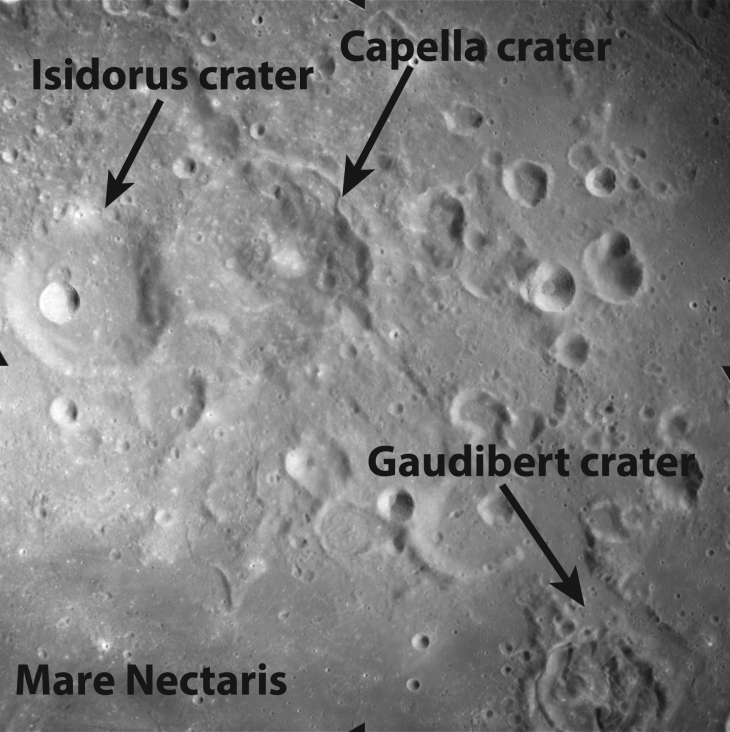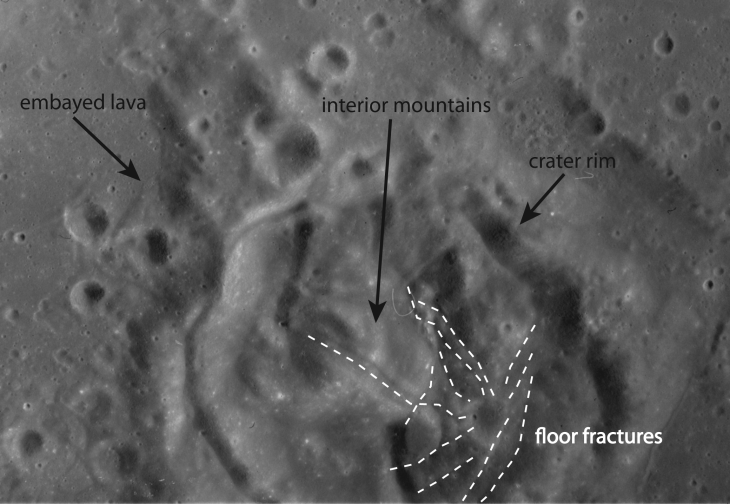
| Project Home | About the Scans | Browse Gallery | Image Map | Support Data | Resources | Ephemeris |
Featured Image - 02/24/2009
Mysterious Gaudibert Crater
Gaudibert crater (Figure 1, 33 km diameter; named after Casimir Gaudibert who was an amateur astronomer in the mid-1800s) is located on the northeastern margin of Mare Nectaris (10.9 ° S, 37.8 ° E) to the southeast of the Isidorus-Capella crater pair. Complex craters (diameters larger than 20 km) such as Sklodowska Crater, King Crater, and Gaudibert generally exhibit a central peak complex and terraced walls.
Figure 1. Gaudibert crater, 33 km in diameter, is located on the northeastern margin of Mare Nectaris and is morphologically different from the surrounding craters. (Apollo Image AS16-M-0424 [NASA/JSC/Arizona State University])
The morphology of Gaudibert (Figure 2) is bizarre compared to other complex craters. While there is a crater rim, it is relatively non-circular and globular as opposed to crisp and distinctly circular. There is an absence of defined wall terraces and slump blocks and the interior of the crater is highly irregular. Instead of a central peak and flat floor, the crater interior appears mountainous, with two to three large mountains located on the crater floor. Several fractures and cracks are present and appear to radiate outward from an origin located in the southeastern portion of the crater interior.
Figure 2. Gaudibert exhibits peculiar morphology: a non-circular, globular rim, a mountainous interior, no observable wall terraces, and floor fractures. (Apollo Image AS16-M-0424 [NASA/JSC/Arizona State University])
Why does Gaudibert appear so different than complex craters in the surrounding area?
Gaudibert does not appear to have an ejecta blanket; a smooth surface of mare lavas surrounds the crater. These lavas make the crater rim look more irregular and have filled in the low-lying areas. Schultz (1976) identifies the floor fractures observed in Gaudibert and other craters as possible evidence of volcanic processes. The morphology of the crater interior is thought to be a result of tectonic uplift due to magma intrusion as a sill beneath the crater floor, intrusion and emplacement of lava on the crater floor through the floor fractures, and subsequent subsidence of the crater floor as the magma source beneath the crater shrinks. Moreover, Clementine UV/VIS data interpretation (e.g., Gaddis et al. 2003) suggests that there are pyroclastic deposits in the interior. The morphology of this crater, coupled with the multispectral Clementine analyses, are evidence of volcanic processes within this crater. Lunar Reconnaissance Orbiter Camera images will greatly improve our understanding of this unique and mysterious crater by help to locate the pyroclastic vents and investigate structural features.
References
C. Coombs et al., 1990. Pyroclastic deposits in the Nectaris region of the Moon, LPSC XXI abstract.
L. Gaddis and USGS Lunar Pyroclastic Volcanism Database
L. Gaddis et al., 2003. Compositional analyses of lunar pyroclastic deposits, Icarus, Vol. 161, pp. 262-280.
P. Schultz, 1976. Floor-fractured lunar craters,The Moon, Vol. 15, pp. 241-273.

|
|
Space Exploration Resources |
|
 LPI LPI
|

